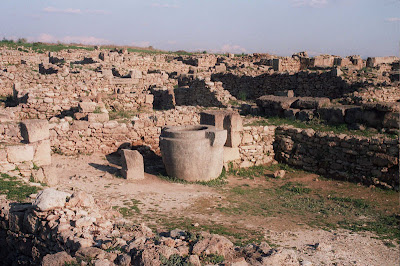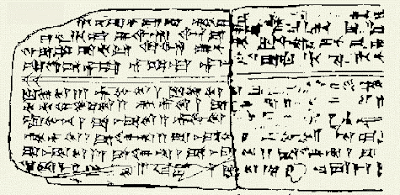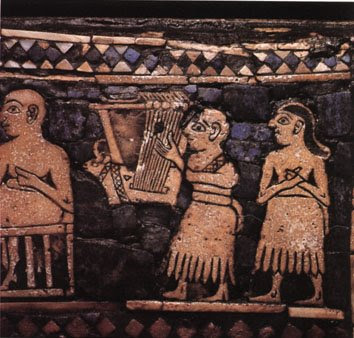
The world's oldest-known preserved music notation, complete with both words and music,

was discovered the 1950's in the ruins of the lost city of Ugari, now Ras Shamra,

on the Mediterranean coast of northern Syria. The site was first discovered by a peasant ploughing a field in 1928. Excavations of the forgotten city revealed Ugarit to be an important cosmopolitan city, both a port and an entrance to an inland trade route through Ancient Mesopotamia, dating as far back as 6000BC.
The tablet, broken into two pieces found at different times, has a horizontal line dividing the top half – the song words – from the bottom half – the instructions for the music.

The clay tablet, one of many unearthed, is marked with cuneiform, meaning "wedge-shaped," signs in the ancient Hurrian language.
Syria - Hurrian Hymn No. 6
The tablets date back to approximately 1400 B.C. and contain a hymn to the moon god's wife, Nikkal.
In the above recording, the realization suggests F Dorian (F G Ab Bb C D Eb F - Do Re Me Fa Sol La Te Do).
After the opening descending octave flourish with a lower turn (Do Do Te La Sol Fa Me Re Do Te Re Do), the melody seems mostly composed of downward and upward scale fragments, some in sequence (i.e. an idea -- or motiv -- repeated at different pitch levels)
Sol Fa Me Re Do
Do Re Me Fa
Sol Fa Me Re Do
Te Do Re Re Me Re Fa Sol (Fa Sol etc. Fa La Sol Fa etc.)
Sol Fa Me Re Re Do Te
Me Fa Sol
Re Me Fa
Do Re Me
Te Do Re
Do Te Do

Remarkably, the tablets also contain detailed performance instructions for a singer accompanied by a harpist as well as instructions on how to tune the harp.

In 1972, after 15 years of research Anne Draffkorn Kilmer (Professor of Assyriology at the University of California, and a curator at the Lowie Museum of Anthropology at Berkeley) transcribed the music as a form of harmony, two or more notes played at the same time, which was previously thought to be non-existent altogether in ancient music.
The top parts were the words and the bottom half instructions for playing the music. The song, in this interpretation, is in the equivalent of the diatonic "major" ("do, re, mi") scale. In addition, as Kilmer points out: "We are able to match the number of syllables in the text of the song with the number of notes indicated by the musical notations." This approach produces harmonies rather than a melody of single notes. The chances the number of syllables would match the notation numbers without intention are astronomical.
Evidence both the seven-note diatonic scale as well as harmony existed 3,400 years ago flies in the face of most musicologist's views that ancient harmony was virtually non-existent (or even impossible) and the scale only about as old as the Ancient Greeks, 2000 years ago. Said Kilmer's colleague Richard Crocker: "This has revolutionized the whole concept of the origin of western music."
In March of 2007 the North American premiere of a vocal rendition of the piece was given at the Oriental Institute on the University of Chicago campus. Dr Theo J. H. Krispijn, a professor in Assyriology at Leiden University in the Netherlands and an accomplished vocalist, performed the song, complete with lyrics, and accompanying himself on a reproduction of an ancient stringed instrument, the lyre.
Krispijn's haunting and sad interpretation is entitled The Prayer of an Infertile Woman, with lyrics, as printed in the Chicago Tribune, including:
She [the goddess] let the married couples have children,
She let them be born to the fathers
But the begotten will cry out, 'She has not borne any child'
Why have not I as a true wife borne children for you?
[Tutankhamen / 5570 Syrian Cuneiform / Egyptian New Kingdom
